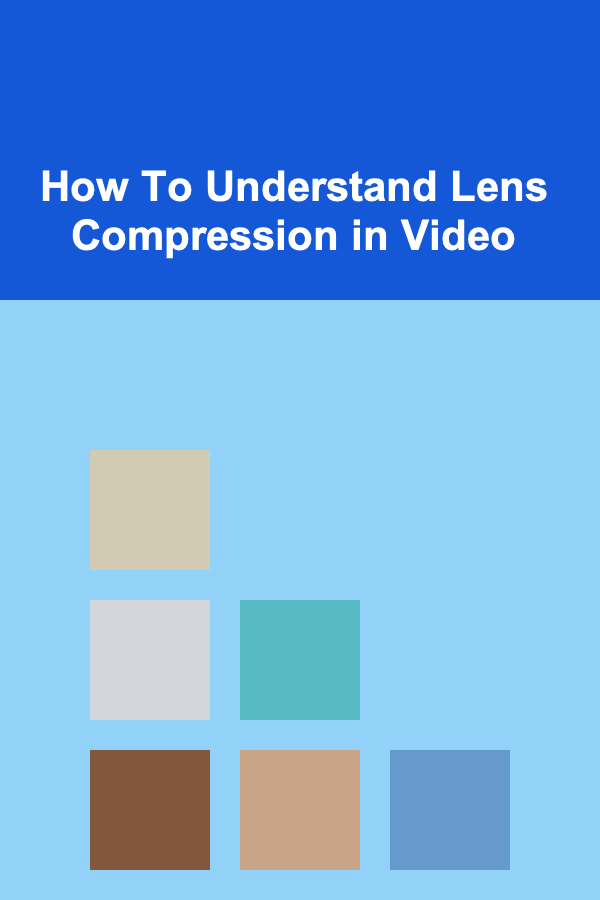
How To Understand Lens Compression in Video
ebook include PDF & Audio bundle (Micro Guide)
$12.99$6.99
Limited Time Offer! Order within the next:

Lens compression is a fundamental concept in video production that plays a significant role in how we perceive space, depth, and scale in a shot. While many video creators might have heard of lens compression, they might not fully understand its impact or how it differs from other optical effects like depth of field. This article aims to dive deep into the concept of lens compression, providing an in-depth understanding of how it works, why it's important, and how to use it effectively in video production.
What is Lens Compression?
Lens compression refers to the visual effect that makes objects appear closer together in a frame than they actually are in reality. This effect is typically associated with the use of longer focal lengths (telephoto lenses) and the distance from the subject. While it sounds straightforward, it's important to note that lens compression is not caused by the lens itself but rather by the perspective and field of view it provides.
The key point to grasp here is that lens compression distorts spatial relationships between objects in a scene. It can either exaggerate or reduce the distance between objects, changing how depth and scale are perceived. A telephoto lens, which has a long focal length, makes objects in the background appear much closer to the foreground, effectively compressing the scene. Conversely, a wide-angle lens (short focal length) tends to exaggerate the distance between objects, stretching them out.
The Relationship Between Focal Length and Compression
To understand lens compression more clearly, it is essential to explore the relationship between focal length and perspective. Focal length refers to the distance from the lens to the image sensor when the lens is focused at infinity. It is typically measured in millimeters (mm), and it affects how much of a scene can be captured by the camera.
- Wide-Angle Lenses (Short Focal Lengths): These lenses have a focal length ranging from about 14mm to 35mm. They provide a wider field of view, capturing more of the scene in the frame. However, they also exaggerate the perceived distance between objects in the foreground and background. The closer objects appear much larger, while distant objects seem much smaller and farther apart.
- Standard Lenses (Medium Focal Lengths): Lenses in the range of 35mm to 70mm provide a perspective that closely resembles how we see the world with our eyes. These lenses offer a balanced compression effect, neither exaggerating nor compressing the distance between objects too much.
- Telephoto Lenses (Long Focal Lengths): Telephoto lenses have focal lengths of 70mm and above. These lenses narrow the field of view and compress the scene. This means that distant objects will appear much closer to the foreground, making the background elements seem compressed or "flattened" into the frame.
How Lens Compression Affects Visual Perception
The primary effect of lens compression is its impact on depth perception. When shooting with a wide-angle lens, objects in the foreground appear larger and more pronounced, while objects in the background appear much smaller and distant. This results in a more dramatic sense of depth and scale in the shot.
In contrast, when using a telephoto lens, the depth is less pronounced, and objects seem to flatten out, with the background appearing to move closer to the foreground. This is why telephoto lenses are often used for portraits, as they can make the background appear more compressed and provide a pleasing, "soft" effect.
Practical Applications of Lens Compression in Video
Understanding lens compression is vital for filmmakers, videographers, and content creators as it allows them to use this optical effect creatively in their work. Here are some common scenarios where lens compression is effectively used:
1. Portrait Photography and Videography
Telephoto lenses are commonly used in portraiture because of their ability to compress the background. By using a longer focal length (such as 85mm or 135mm), a videographer can isolate the subject from the background, making it appear closer and creating a visually pleasing blur (bokeh). The compression effect also makes the subject's features appear more flattering by reducing the distortion caused by wide-angle lenses.
In addition to creating a pleasant aesthetic, the compressed background helps direct the viewer's attention solely to the subject without distractions from the environment.
2. Landscape and Cityscape Shots
While telephoto lenses are often associated with portraits, they can also be used creatively in landscape and cityscape videography. When shooting distant scenes, a telephoto lens will compress the elements of the landscape, making them appear to be stacked together. This can be particularly useful in capturing vast landscapes, such as mountain ranges or urban skylines, where the compression effect gives the illusion of a closer, more dynamic composition.
3. Action and Sports Filmmaking
In action or sports filmmaking, lens compression can be used to exaggerate the speed and intensity of a scene. By using a telephoto lens, objects or people in the distance can appear to close the gap with the camera, making fast-moving subjects appear even more dramatic. For instance, capturing a race or a fight with a long lens can create a feeling of tension and excitement as the background is compressed.
4. Creating Cinematic Depth
Many filmmakers use lens compression to create a cinematic look with an exaggerated sense of depth. By using a telephoto lens, filmmakers can make the scene appear more layered, even if the physical space is not particularly deep. This can add a sense of grandeur or dramatic effect to scenes, especially when there is a foreground subject in close proximity to the camera.
5. Achieving Isolation of Subjects
Lens compression can be particularly effective for isolating subjects within a scene. By compressing the background, you can make the subject stand out more starkly against a seemingly closer backdrop, which can be ideal for scenes where you want to highlight a person or object in a busy environment. The compression effect helps eliminate distractions and makes the subject the focal point of the shot.
Limitations of Lens Compression
While lens compression can be incredibly useful, it is important to understand its limitations and potential drawbacks. One of the primary issues with compression is that it can sometimes result in a loss of perceived depth, which may make the shot feel flat. This is particularly true when overusing long focal lengths, as excessive compression can make a scene appear overly "packed" or "squeezed," which may not suit every type of shot or subject.
Moreover, lens compression is an optical effect, so it does not affect the physical space in the environment. For instance, if you are using a telephoto lens to create compression, it will not bring the background physically closer to the subject. It only alters how we perceive the space within the frame.
Choosing the Right Lens for Compression
When deciding on the right lens to achieve the desired level of compression, there are a few factors to consider:
- The Scene and Composition: If you are trying to emphasize a subject in a busy environment, a telephoto lens may be ideal to compress the background and make the subject stand out. However, if you want to capture a vast, expansive landscape, a wide-angle lens may be more appropriate, as it will exaggerate the distance between elements and create a sense of space.
- The Desired Depth: Consider how much depth you want to convey. Wide-angle lenses will give you a more pronounced sense of depth and dimension, while telephoto lenses will flatten the scene. For a shot with a lot of foreground and background separation, a wide-angle lens may be the best choice.
- The Aesthetic of the Shot: Think about the emotional tone of your shot. Telephoto lenses often create a more intimate, compressed feel, while wide-angle lenses can produce a more dynamic and expansive feeling. Understanding how lens compression impacts the mood of the shot is crucial to making the right choice.
Conclusion
Understanding lens compression is a critical aspect of video production that directly influences how depth, space, and scale are perceived by the audience. The relationship between focal length and compression is fundamental in shaping the visual narrative of your video. By experimenting with different lenses and focal lengths, you can creatively manipulate the perception of depth and distance in your shots, ultimately enhancing the storytelling aspect of your work.
Whether you're shooting a dramatic portrait, an expansive cityscape, or an action-packed scene, mastering lens compression allows you to shape the viewer's experience and control how your scenes are perceived. By learning how to use compression effectively, you can bring a professional and cinematic touch to your video production, elevating both the aesthetic and emotional impact of your work.

How to Manage Paper Clutter in Your Workspace
Read More
How to Transition from Paper to Digital: Using an Online Household Budget Planner
Read More
How to Safely Use Public Wi-Fi Networks
Read More
How To Repair a Damaged Garden Hose Reel
Read More
How to Post-Process and Paint 3D Prints
Read More
Selecting the Best Piping Bags and Tips for Cake Decorating
Read MoreOther Products

How to Manage Paper Clutter in Your Workspace
Read More
How to Transition from Paper to Digital: Using an Online Household Budget Planner
Read More
How to Safely Use Public Wi-Fi Networks
Read More
How To Repair a Damaged Garden Hose Reel
Read More
How to Post-Process and Paint 3D Prints
Read More